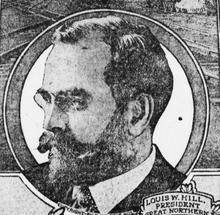Louis W. Hill
| Louis Warren Hill | |
|---|---|

Hill about 1909
|
|
| Born |
May 19, 1872 Saint Paul, Minnesota |
| Died | April 27, 1948 (aged 75) Saint Paul, Minnesota |
| Nationality | American |
| Occupation | President of Great Northern Railway |
| Spouse(s) | Maud Van Cortlandt Taylor |
| Children | 4 |
Louis Warren Hill (May 19, 1872– April 27, 1948), was an American railroad executive. He was the president and board chairman of the Great Northern Railway, which served a substantial area of the Upper Midwest, the northern Great Plains, and Pacific Northwest.
The third of James J. Hill and Mary Mehegan Hill’s ten children, Louis Warren Hill was born in St. Paul, Minnesota in 1872. He, along with his older brother James, was schooled at home before attending Phillips Exeter Academy in New Hampshire and Yale University.
He began working for his father at the Great Northern Railway Company immediately after graduation and began pursuit of his own ultimately extremely successful investments in iron mining in northeastern Minnesota. While the eldest Hill son James had been groomed as their father’s successor, Louis’s capable management of a Great Northern extension over the Rockies in 1901 moved him into position as heir to the Hill business empire.
In 1901 Louis married Maud Van Cortlandt Taylor, child of a well-known New York family. The couple moved into a large home next door to James J. and Mary Hill on Summit Avenue in St. Paul and together had four children: Louis Warren Jr., James Jerome II (always called Jerome), Maud Van Cortlandt and Cortlandt Taylor. The family traveled the United States and the world and spent much of their time at North Oaks Farm, just north of St. Paul, where Louis built a chalet-style retreat.
In the mid ‘00s Louis began to take over management of the Great Northern Railway. He was named president in 1907 and board chairman in 1912, although his father James continued to retain much control until his death in 1916. Louis expanded his interests far beyond railroads: he was at the forefront of the oil and auto transport industries and was a major player in land development in Montana and California, in finance, and in copper mining.
One of Louis’ greatest legacies was his enthusiastic promotion of U.S. tourism and the national park system. He was a major force in the creation, promotion, and development of Glacier National Park in Montana, where he built several resorts. He also maintained an interest in the American Indian tribes of Montana and became a collector of Blackfoot material, now housed in the Science Museum of Minnesota.
...
Wikipedia
